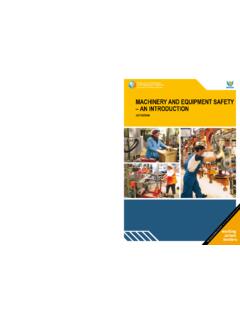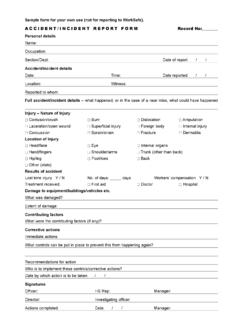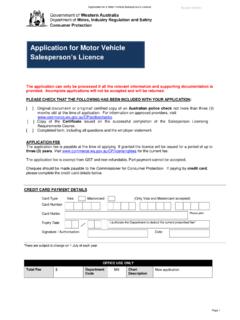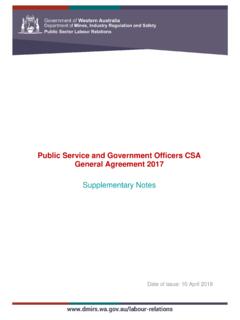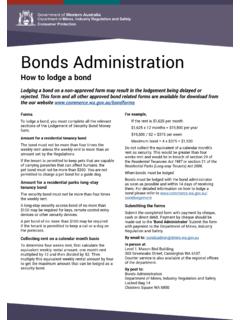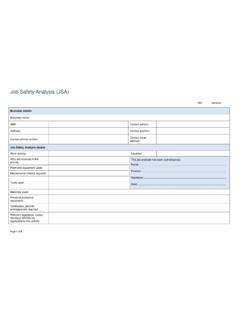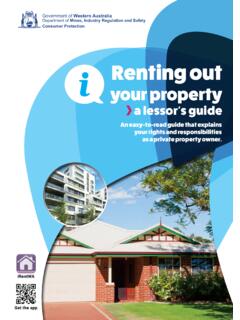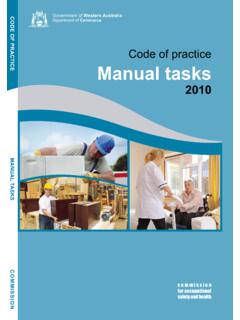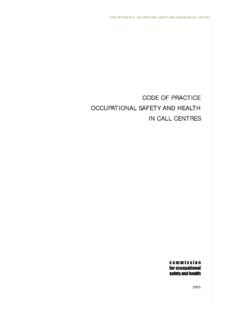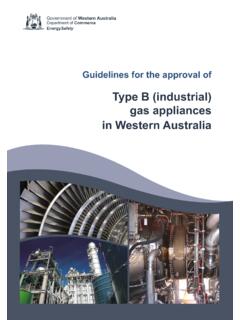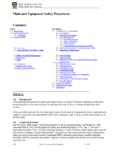Transcription of Home based care information and checklist
1 Level 1 Mason Bird Building 303 Sevenoaks Street (entrance Grose Avenue) Cannington Western Australia 6107 Website: Email: Regional Offices Great Southern (08) 9842 8366 Mid-West (08) 9920 9800 South-West (08) 9722 2888 home based care information and checklist Contents Introduction .. 2 Occupational safety and health Who is responsible? .. 2 How are workers getting hurt? .. 2 Manual tasks .. 3 Slips, trips and falls .. 5 Workplace violence and aggression .. 6 Working alone .. 8 Electrical hazards .. 9 Infectious diseases, sharps and body fluids .. 10 checklist Psychosocial issues/interpersonal conflict/stress .. 11 checklist Hazardous substances .. 11 checklist External hazards .. 12 checklist Vehicle safety .. 12 checklist First aid .. 13 checklist OSH management .. 13 information to help you meet the OSH laws .. 14 Page | 2 Introduction People who work in the field of home and community health care face unique challenges in managing work health and safety.
2 An increased demand for services that allow people to stay in their own homes and new working arrangements in aged and disability care highlights the need for further guidance in managing occupational safety and health challenges that arise when providing a service within homes or community settings. This guide outlines common hazards found in the community services sector, primarily in the home environment, and provides solutions based on the principles of risk management. Occupational safety and health Who is responsible? The responsibility to manage the occupational safety and health of workers in community care settings is dependent on how work is arranged and what hazards individuals or organisations have control over. A service provider or host employer who engages a worker to work in a client s home or community setting is responsible to do what is reasonably practicable to ensure the health and safety of workers is protected.
3 Participants in the National Disability Insurance Scheme (NDIS) can choose to engage a disability service provider, an independent contractor (with their own ABN) or directly employ a worker. When directly employing a worker or contracting work, plan nominees and participants have a duty of care under the Occupational Safety and Health Act 1984 (OSH Act) as employers. Workers, including subcontractors or agency staff, also have a duty of care to: take reasonable care for their own health and safety take reasonable care that they do not adversely affect the health and safety of others comply, so far as they are reasonably able, with work health and safety instructions and cooperate with the employer s policies or procedures about work health and safety. This may include following reasonable instructions relating to the delivery of services and using personal protective equipment (PPE) they have been provided and trained in using.
4 Finally, clients have some responsibilities to providing a safe workplace for workers coming into their home , in terms of those hazards within their control. WorkSafe suggests that occupational safety and health roles, responsibilities and rights are defined in a care agreement prior to commencement of services. The agreement should outline the process for reporting hazards and injuries, and advise of how hazards can be resolved. Examples of items that may be covered in a care agreement include: restraint of pets during visits to a client home smoking policies for clients and workers equipment provision and maintenance, hoists, commodes, shower chairs, mops, vacuum cleaners) controlling the risk of aggression, abuse or harassment addressing identified safety issues ( trip hazards, lighting, faulty equipment ) visitor restrictions during visits to a client home how to respond to emergency situations controlling access into and out of the home during visits How are workers getting hurt?
5 Lost time injury data shows that the most common injuries within community and home based care are from: manual tasks; slips, trips and falls; and occupational violence and aggression. Guidance on addressing these main injury risks as well as other common hazards found in community and home care is provided below. Hazards covered in checklists include: Manual tasks Slips, trips and falls Occupational violence/aggression Psychosocial issues/stress Biological hazards Hazardous substances Electrical hazards External hazards Vehicle hazards Working alone OSH Systems Page | 3 Manual tasks What are manual tasks? Manual tasks cover any activity that requires a person to use their physical body (musculoskeletal system) to perform work. It includes manual handling, performing repetitive actions, adopting awkward and sustained postures, and being exposed to vibration while working.
6 Manual tasks can result in both acute (immediate or sudden from a specific incident) or chronic (develops over time) injury. Workers in home based care are most at risk from transfers and handling of clients (who may potentially be resistive to care ); working in awkward/sustained postures (for example cleaning hard to reach areas or in a confined bathroom while assisting a client with showering tasks or dressing;) and handling heavy loads (for example loading/unloading wheelchairs, shopping or other equipment from vehicles; carrying or moving cleaning equipment or assistive aids). However, the above tasks are only a few of the manual tasks that may cause injury. Any task that involves high force, use of awkward or sustained postures, or repetitive movements may result in injury to employees. These tasks need to be identified and addressed through a risk management process to reduce the likelihood of injury All manual task hazards that workers may be exposed to in the course of their work should be identified in consultation with workers and take into consideration tasks they find difficult or demanding, the environments where work will be conducted, and information available from previous injuries, client care plans or pre-service home risk assessments.
7 Risk factors need to be considered, for example actions and postures; forces and loads; vibration; work environment; systems of work; and worker characteristics please refer to the WA Manual Tasks Code of Practice for more information . What training should be provided on manual tasks? Manual task training should include information on: Risk management process (empowering workers to report hazards) Common hazardous manual tasks associated with the work, the types of injuries which may result and general information on how the body works/responds when performing these tasks Risk factors for manual tasks (so that employees are able to identify when a task is hazardous) Available controls to manage risks Task specific training (specific techniques for working safely for example client handling; safe pushing/pulling; loading/unloading vehicles) Training should occur as part of induction, and be refreshed on a yearly basis.
8 Further training may be needed whenever tasks are changed or new tasks are introduced (for example, hoist training for employees who are starting work with a client using a hoist). In addition, support workers should be trained to recognise changes in a client s level of function as these changes can be a potential hazard. Any changes in function should be reported immediately to allow timely re-assessment of the client by a suitably-trained professional to determine if any changes are needed to their care plan and prevent injuries to staff. Page | 4 checklist - Manual tasks Have all manual task hazards been identified? For example; client transfers (bed, wheelchair, car, commode, shower chair, hoist) loading/unloading vehicles carrying equipment to homes client movement (in wheelchairs, wheeled equipment , bed mobility) change in client function or mobility bariatric care issues moving furniture cleaning, gardening, shopping, or maintenance tasks other?
9 Has a risk assessment been completed for all identified hazards, in consultation with workers? Are control measures in place to minimise manual task injuries? suitable, well-maintained client handling equipment is readily available and accessible trolleys available for moving equipment to/from and within homes mechanical aids/lifting devices ( hoists/slide sheets; wheelchair loaders for vehicles) are available when required regular maintenance of home - based equipment and reporting mechanisms for unsafe equipment procedures for clear response and action to client function changes a no lift policy to eliminate movement of furniture, unassisted lifting of clients, etc. bed heights adjusted to minimise bending for transfers or bedmaking review manual handling needs of clients if their condition changes work tasks designed to alternate between heavier and lighter activities and allow sufficient rest breaks use of equipment to prevent over-stretching hand-held shower head, long-handled dusters equipment stored within easy reach between shoulder and mid-thigh height to avoid bending or reaching staff are trained in safe use of equipment Are implemented control measures regularly reviewed, in consultation with staff, to ensure continued appropriateness and effectiveness of control over time?
10 If employer provides equipment such as mops and vacuum cleaners for workers to use, is it appropriate for minimising manual task risks? ( light weight, easy to use, regularly maintained) see WorkSafe WA Manual Task Solutions: Mops and Vacuums for guidance Are workers provided sufficient information on hazardous manual tasks and how to minimise exposure? Have workers received clear guidance on reporting manual task risks? Identify the manual tasks hazards Provide training Conduct a risk assessment Report hazards Trolleys are maintained Page | 5 Slips, trips and falls Slips, trips and falls are the second most common injury (after manual task injuries) for workers in this industry, however they can be prevented. A good understanding of the risk factors that contribute to slips, trips and falls is essential for managers clients and workers to prevent injuries. By understanding risk factors, workers will recognise slip and trip hazards in their work, and are more likely to report these hazards to the employer.
